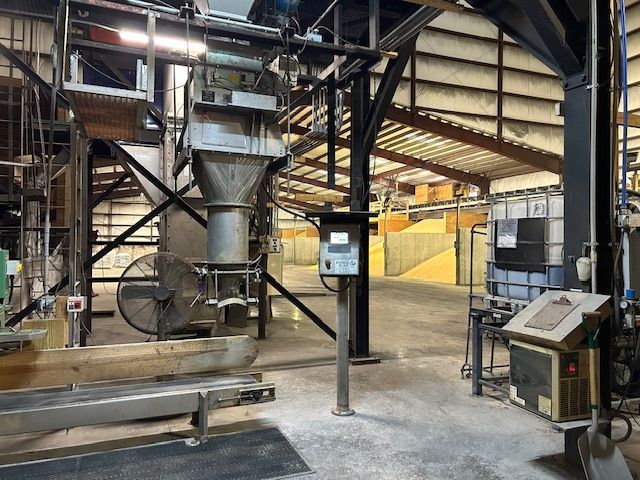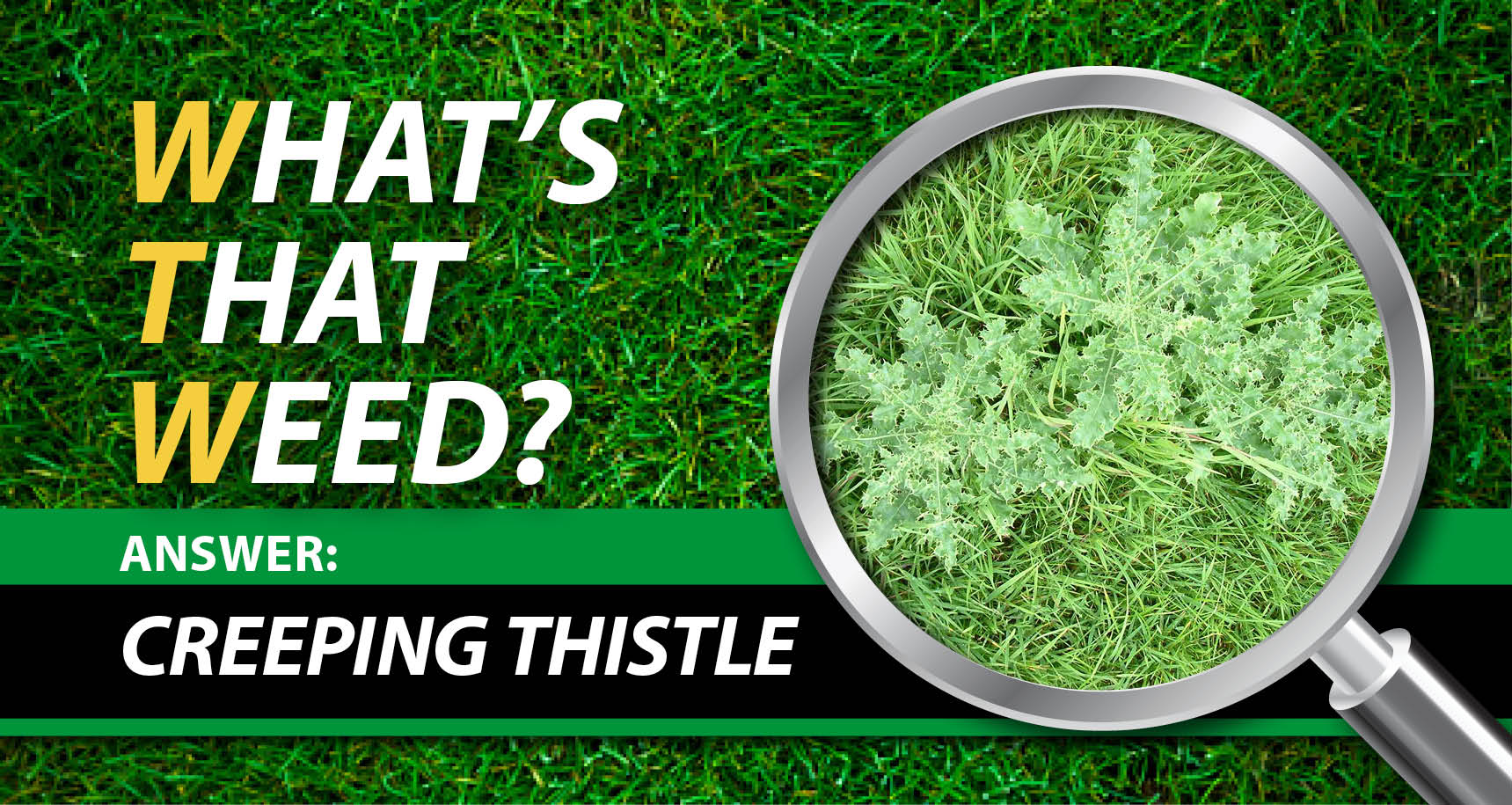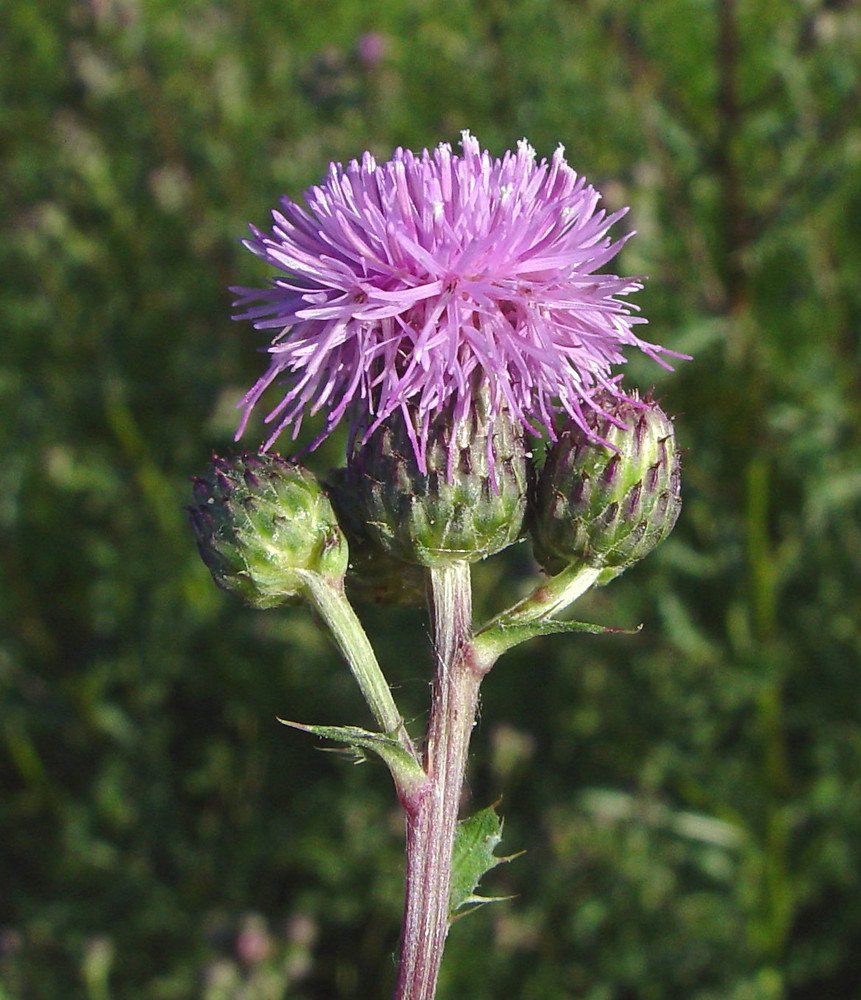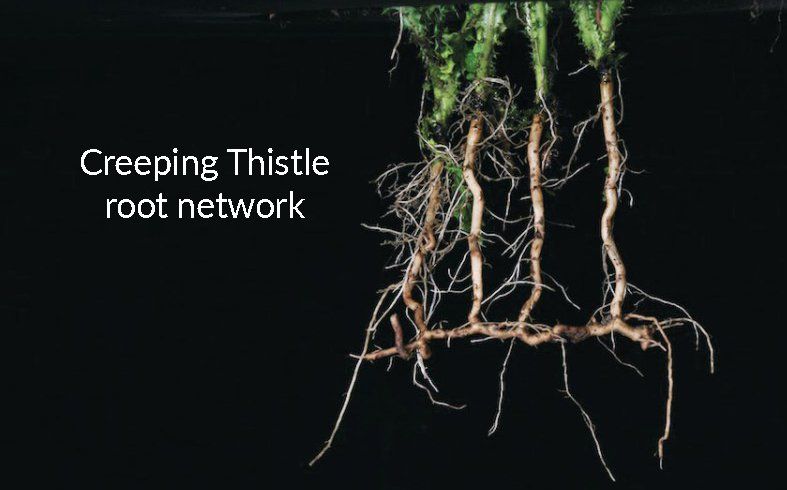TYPE
Creeping Thistle is an herbaceous perennial weed with sharp, prickly leaves (sometimes with lilac-pink flowers) that emerges in early June and can infest landscapes throughout the U.S. through late October. A member of the Asteraceae family of thistles, this weed can spread rapidly via its highly aggressive spreading root system, or its ability to scatter thousands of seeds in a short time.
WHERE IT GROWS
Native to Europe and Asia, this weed has been widely introduced to most of the globe. In the eastern U.S., it dominates north of the Ohio River and the Mason-Dixson line (with exception to West Virginia, where it is has also become well-established). West of the Mississippi River, Creeping Thistle has spread across most of the United States with exception to the southern Great Plains.
Creeping Thistle is the most common thistle species in the U.S. It prefers recently disturbed/cultivated grounds (such as vegetable gardens), road side and field edges, and other patches of relatively barren soil. Barren patches of turf provide an ideal germinating for wind-dispersed thistle seeds. The best defense against a creeping thistle invasion is a dense, well-established turf.
HOW TO IDENTIFY
Creeping Thistle consists of tiny pink/lilac florets which comprise a larger flower head. Each complete head sits atop a spiny bract (a circular arrangement of leaf-like tissues at the apex of the stem). Its slender green stem ranges anywhere from 30 to 150cm tall. Its spiny leaves alternate around the stem, topping out around 20cm in length. Regularly mowed turf is unlikely to see this weed in the flowering stage, however Creeping Thistle is notorious for its spiny leaves which can leave a painful prick.
GROWING SEASON
Creeping Thistle tends to emerge from the soil in early June, with its bright purple flowers dominating roadside landscapes by mid-July. When large stands of this weed begin to seed, the flower heads take on a dense cotton-like appearance. A burst of wind can send thousands of seeds into the air in a matter of seconds. Creeping Thistle continues growing and flowering through October.
HOW TO MANAGE
There are two ways to remove Creeping Thistle, hand removal or herbicide. You can hand remove Creeping Thistle from gardens or lawns using thick gloves to avoid their prickly leaves. However, since Creeping Thistle produces an extensive root network so you need to assure all roots have been successfully removed to avoid re-establishment (even traces of roots can lead to new thistle shoots). Each individual plant can send up multiple shoots, giving the appearance that there are many more individual plants than in reality. In addition, when removing by hand you want to avoid spreading the flower's light fluffy seeds. In order to prevent germination of thistle seeds, make sure any large thistle stands are removed before flowering. Creeping Thistle seeds can quickly be blown to other areas of your landscape and rapidly take over. Once removed, throw the weed away and do not try to compost them because traces of roots or seeds will quickly establish new plants.
If herbicides are the preferred method of removing Creeping Thistle, apply when the weed is actively growing in the spring or early fall. You can use a broad-spectrum herbicide that will not damage trees or other ornamentals in a shared root zone (such as 2,4-D MCPA, Triclopyr or Dicamba) or a non-selective herbicide (glyphosate) when you can safely target the weed directly. In most cases, apply the herbicide in a heavier than normal concentration, as Creeping Thistle has a root network often larger than its above ground shoot mass and multiple treatments may be necessary. Once applied, DO NOT mow or cut back the thistle in any way; allow the herbicide to absorb into the shoot tissue so that it may be transported down to the roots.
PREVENTION
Creeping Thistle typically thrives in low fertility soils so amending the soil and improving the environment for your preferred plants and turf can reduce its appearance. You can also avoid this weed by applying a pre-emergent herbicide/fertilizer application in the early spring that will prevent it, or any thistle species, from taking hold of your lawn throughout the season.
For professional fertilizers, humic and AMP-XC™ enriched products available, please visit TurfCare’s online Product Catalog.
For green industry professionals or others interested in ordering Turfcare products, please contact our Customer Service
to find a distributor near you.
Resources:
http://homeguides.sfgate.com/control-creeping-thistle-24281.html
http://www.wildlifetrusts.org/species/creeping-thistle
https://www.uaf.edu/files/ces/cnipm/k12/webinars/Creeping%20thistle%20management.pd
http://www.organicresearchcentre.com/manage/authincludes/article_uploads/1716-thistle.pdf
https://www.wyevalegardencentres.co.uk/tips-and-advice_how-to-control-creeping-thistle
https://www.wikihow.com/Get-Rid-of-Thistles
http://uk.dowagro.com/wp-content/uploads/2014/03/creeping-thistles.jpg
http://newfs.s3.amazonaws.com/taxon-images-1000s1000/Asteraceae/cirsium-arvense-fl-ahaines-a.jpg
http://bugwoodcloud.org/maps/eddmapscounty/2792.jpg
http://image2.gardenersworld.com/image.jpg?tag=d0ecc140-f2e7-4812-87f9-c318299e0790
http://wynnstaydairy.uk/get-tough-with-thistles/
Turf Care Supply - TurfReport Blog

Turf Care Supply, LLC, a portfolio company of Platte River Equity, has officially acquired Beaty Fertilizer, the industry respected Tennessee-based manufacturer and blender of custom granular and liquid fertilizers, as well as combination products. This strategic move expands Turf Care’s manufacturing footprint, adds new product capabilities, and enhances overall production capacity. “The partnership with Beaty Fertilizer marks a major milestone in our journey and an important step forward in our mission to grow, innovate and lead in our industry,” said Mark Mangan, President of Turf Care. “This acquisition is more than just expansion; it’s a powerful opportunity to strengthen our product offerings, broaden our market reach and provide greater value to our customers. By welcoming Beaty into the Turf Care family, we are reinforcing our commitment to excellence and positioning ourselves for an even brighter future.” “We are excited about this next step in the Beaty Fertilizer story. For almost 50 years, our family and our employees have worked hard to serve customers and communities with pride and heart,” said John Beaty, President of Beaty. “Now, we are embracing an opportunity for growth with Turf Care. With our combined know-how and resources, we’ll keep building on what we’ve worked so hard to create and bring even more value to our customers, employees and partners. We truly believe this partnership will keep the Beaty legacy going strong while opening up new doors for growth and innovation.” Tarun Kanthety, Vice President at Platte River, added, “We believe the acquisition of Beaty Fertilizer represents a strategic step in expanding Turf Care’s footprint and product breadth... as it scales and enhances its value proposition to customers.”

Root out Grubs, Before they Attack Yours! White grubs, the immature stage of several scarab beetles—including Japanese beetles, masked chafers, May and June beetles, and green June beetles—are a major threat to turfgrass across the Southeast. These beetles follow a complete metamorphosis (egg, grub, pupa, adult), with most species completing their cycle in one year. Eggs are laid in early summer, grubs hatch within two weeks, and begin feeding on turfgrass roots through the late summer and fall. May and June beetles differ slightly, with a two- to three-year life cycle and prolonged feeding as third-instar grubs. Grubs damage turf by severing roots, causing grass to yellow, wilt, or lift easily from the soil. Feeding is typically concentrated in patches and worsens during hot, dry weather. Wildlife digging for grubs can create further turf destruction. Healthy turf may tolerate 5–10 grubs per square foot, but damage becomes evident as populations rise or turf is under stress. Early detection and timing are essential. Scouting begins in late June, shortly after adult beetle activity peaks. Monitoring plants favored by beetles can signal egg-laying is underway. Treatment is most effective when small grubs are active—typically from mid-July through early August. For professional turfgrass managers, insecticides containing imidacloprid (Merit®), chlorantraniliprole (Acelepryn®), or trichlorfon (Dylox®) are the most effective tools. The primary months of preventative application of Acelepryn® is from April to end of May and Merit® from April into July - targeting grubs before they hatch. Curative treatments with Dylox® or similar products are applied July through the fall, when young grubs are feeding and most vulnerable. Always follow label directions for optimal application and safety. Timing may vary slightly by regional seasonal needs. Turf Care Supply has a variety of professional TCS Growstar insecticide fertilizers available to protect your turf and prevent grub damage, before it starts. Click on the button below to view products, contact your sales rep for addition TC Growstar products available.

Platte River Equity Portfolio Company Turf Care Supply, LLC Acquires Agri-Nutrients, Inc. Brunswick, OH , October 9, 2024 – Platte River Equity (“Platte River”) portfolio company Turf Care Supply, LLC (“Turf Care”) is pleased to announce its acquisition of Agri-Nutrients, Inc. (“Agri-Nutrients”), a manufacturer and blender of custom granular fertilizers for the turf & ornamental (“T&O”) industry. This strategic acquisition provides Turf Care with an established presence in the south-central United States, an enhanced product portfolio and additional manufacturing capacity. “This acquisition represents much more than a business transaction; it is a strategic step forward in expanding our reach and enhancing our customers’ growth. By bringing Agri-Nutrients into the Turf Care family, we are broadening our product portfolio, expanding our market presence and further positioning ourselves as a leader in providing innovative solutions for our customers,” said Mark Mangan, President of Turf Care. “We are excited about joining the Turf Care team,” said Jim Montgomery, President of Agri-Nutrients. “At Agri-Nutrients, our core values center around customer service and product innovation, and we are confident that this combination will allow us to better serve the needs of our customers.” “Platte River welcomes the Agri-Nutrients team to Turf Care. This transaction underscores our long-term commitment to fostering growth through both organic and inorganic initiatives across the Turf Care platform,” said Tarun Kanthety, Vice President of Platte River. “The partnership with Agri-Nutrients strengthens Turf Care’s value-added offering, creating additional growth opportunities across the combined customer base.” B&A Corporate Advisors served as the exclusive financial advisor to Agri-Nutrients. About Agri-Nutrients Founded in 1992 and based in Catoosa, OK, Agri-Nutrients is a manufacturer and blender of custom granular fertilizers for the T&O industry, predominantly selling into the lawn care, sports turf and golf course end markets. About Turf Care Supply Established in 1974, Turf Care Supply is one of the largest formulators and blenders of urea products to the T&O market. Turf Care has a comprehensive product portfolio of fertilizers, combination products (herbicide/insecticide), soil amendments and enhanced efficiency fertilizer ingredients. Turf Care's products are sold to distributors and blenders serving the commercial, residential and golf end markets. Turf Care operates four manufacturing facilities strategically located throughout the eastern U.S. About Platte River Equity Founded in 2006 and based in Denver, CO, Platte River Equity is a private equity firm focused on investments in established lower middle market operating companies within targeted industrial sectors where it has substantial operating and investing experience. Platte River utilizes prudent capital structures in order to invest in future growth opportunities and withstand changing economic environments. The firm also provides significant ongoing support to its portfolio companies through dedicated resources across functional areas. The firm has raised funds with committed capital in excess of $1.6 billion and is currently investing out of its fifth fund. The Platte River team is the largest collective investor across its funds, deeply aligning the firm with its investors and portfolio company management teams.




